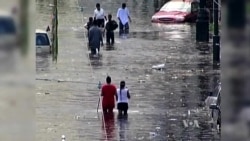Scientists from the U.S. and Europe have a new eye in the sky monitoring the world's oceans.The Jason-3 satellite, launched on January 17, is the latest satellite to monitor rising sea levels. Scientists say data collected by satellites over the last two decades shows sea levels rising at an accelerating rate, which they say is an indicator of climate change.
Josh Willis, Lead Project Scientist for the Jason-3 mission at NASA’s Jet Propulsion Laboratory said rising sea levels were one of the factors that contributed to the destruction wrought by Hurricane Katrina in 2005. Hundreds of people died and the storm surge devastated gulf coast communities as Katrina became one of the deadliest storms in recent U.S. history.
"The rising ocean winds up causing problems when it comes on top of things like storm surges, high tides, and rare events which bring very high sea levels," said Willis.
Jason-3 collects data by pulsing radar off the ocean surface several thousands of times a second and returns it back to the satellite.
"Our satellite records of course only go back about 25 years. But we have measurements of how the oceans have been changing that go back thousands of years and in fact the past 2000 years have been very stable in terms of sea level and climate change. It’s only in the last hundred or so years that rapid sea level rise has begun, driven by the warming of the planet," Willis said.
Any material, including water, expands when heated. The Jason-3 satellite measures the height of the sea surface, allowing scientists to calculate how much extra heat is stored in the ocean.
Lee-Lueng Fu, the project scientist for the Jason-2 mission at NASA's Jet Propulsion Laboratory, said the ocean covers 70 percent of the Earth’s surface, and more than 90 percent of the heat trapped by greenhouse gases ends up in the ocean.
"So we are entering a very unique time that greenhouse gas is increasing at an unprecedented pace --50 percent increase in less than 150 years so that’s just a fact," he said. "So a lot of warming happening in a very short time and sea level is rising at a pace [that is] very rapid."
The National Oceanic and Atmospheric Administration’s Eric Leuliette said sea levels are an expression of climate change for two reasons.
"One is that excess heat that goes in the ocean is causing the ocean to expand," he said. "On top of that, as the glaciers and ice sheets melt due to global warming nearly all that water runs into the ocean also causing the ocean to rise."
Leuliette said the data collected from the Jason-3 satellite will help them to continue to monitor the global impacts of rising sea levels, including increased floods.The information collected by the satellite will also help meteorologists better forecast the intensity of big storms such as Hurricane Katrina.
"When hurricane Katrina was passing over we could see the spot of warm water using the Jason data that caused the hurricane to intensify from a category three to a category five hurricane," said Leuliette.
Once the Jason-3 Satellite retires in three to five years, scientists plan to launch another satellite to continue the mission of building a satellite record of sea level rise on Earth.






